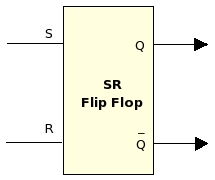Flip flops are heart of digital electronics. Without this component digital electronics would have never reached the position where it is today. To make the next topic "555 timer" clearer, I would like to cover a small introduction of flip flops here. They will be discussed in detail in "digital electronics" section.
In early days when digital electronics was not so evolved, days when even transistor was not invented, people used to use "relays" as electronics switches for switching. Even whole telephone exchanges were built using such relays. One interesting fact about these relays is that they produce a typical "click" sound when the metal contactors inside make contact, and "clack" as they get apart.
When transistor was invented , these switches were replaced by transistor based switches and these transistor switches got their name from relay's "click clack" sound as "flip flop". Interesting !! Isn't it ?
Schematically, a flip-flop can be represented as shown below. This is a S-R(set/reset) flip-flop. All other flip-flops i.e J-K flip-flop, D flip-flop and T flip-flop can be derived from S-R flip-flop.

Lets see how this works..
- Q and Q-bar are outputs. As name suggest, Logic level on these will ways complement to each other.
- Any momentarily logic-1 (5 volts) applied to S (set pin) will set the output of Q to high (logic-1).
- Logic-1 on Q will be latched, even if logic-1 from S pin is removed now.
- Logic-1 on Q can be reseted to logic-0 (0 volts) by applying momentarily logic-1 to R reset pin.
* please note that here logic-1 means 5V DC, and logic-0 means 0V DC.
Because of this property of flip-flops to hold or latch output, these are very much used as memory component.
